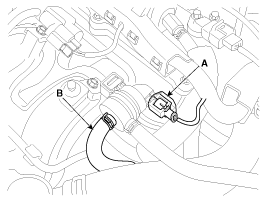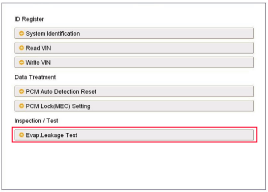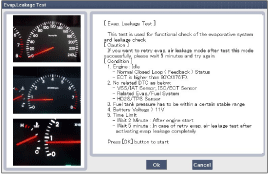 Hyundai Veloster: Repair procedures
Hyundai Veloster 2011-2017 Service Manual / Emission Control System / Evaporative Emission Control System / Repair procedures
Hyundai Veloster: Repair procedures
Hyundai Veloster 2011-2017 Service Manual / Emission Control System / Evaporative Emission Control System / Repair procedures
Inspection
[System Inspection]
| 1. |
Disconnect the vapor hose from the intake manifold and connect
a vacuum pump to the nipple on the intake manifold.
· At Cold Engine [Engine Coolant Temperature < 60°C(140°F)]
|
| 2. |
Check the following points with applied vacuum at the purge control
solenoid valve (PCSV).
· At Warmed Engine [Engine Coolant Temperature > 80°C(176°F)]
|
[PCSV Inspection]
| 1. |
Turn ignition switch OFF and disconnect the negative (-) battery
cable.
|
| 2. |
Disconnect the PCSV connector (A).
|
| 3. |
Disconnect the vapor hose (B) which is connected to the intake
manifold from the PCSV.
|
| 4. |
After connecting a vacuum pump to the nipple, apply vacuum.
|
| 5. |
With the PCSV control line grounded, check the valve operation
with battery voltage applied to the PCSV(Open) and removed(Closed).
|
| 6. |
Measure the coil resistance of the PCSV.
|
[EVAP. Leakage Test]
| 1. |
Select "Evap. Leakage Test".
|
| 2. |
Proceed with the test according to the screen introductions.
|
 Schematic Diagrams
Schematic Diagrams
Schematic Diagram
Canister
The Canister is filled with charcoal and absorbs evaporated fuel vapor
from the fuel tank. The gathered fuel vapor in canister is drawn into the intake
m ...
 Canister. Repair procedures
Canister. Repair procedures
Removal
1.
Turn the ignition switch OFF and disconnect the battery negative
(-) cable.
2.
Lift the vehicle.
3.
...
See also:
Fuel Pump. Repair procedures
Removal
1.
Release the residual pressure in fuel line (Refer to “Release
Residual Pressure in Fuel Line” in this group).
2.
Remove th ...
To connect using the phone settings
Your phone's Bluetooth feature may be set to off by default. To use the Bluetooth
feature, Bluetooth must be turned on in your phone. Refer to your phone's user guide.
1. Enable the phone&# ...
Rocking the vehicle
If it is necessary to rock the vehicle to free it from snow, sand, or mud, first
turn the steering wheel right and left to clear the area around your front wheels.
Then, shift back and forth betwe ...
Categories
- Hyundai Veloster Manuals Home
- Hyundai Veloster 2010-2017 Owner's Manual
- Hyundai Veloster 2010-2017 Service Manual



